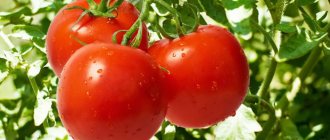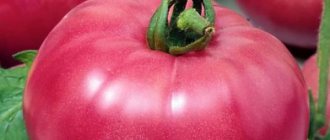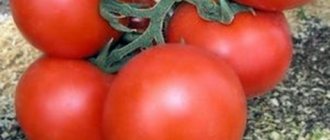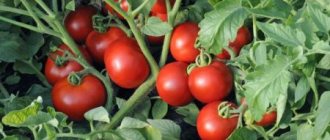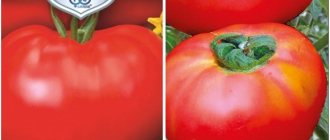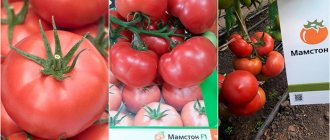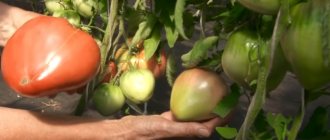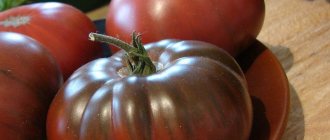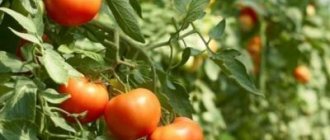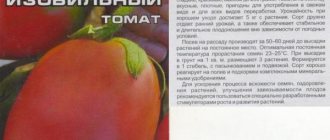The Velmozha tomato belongs to the group of pink heart-shaped tomatoes, which includes the Bull's Heart. It is characterized by the same meatiness, sweetness and high yield. In addition, the variety is easy to cultivate and has high tolerance to temperature changes.
| Height | Landing location | Ripening time | Fruit color | Fruit size | Origin | Fruit shape |
| short | Greenhouse, Open ground | Mid-season | Pink | Large | Variety | Heart-shaped |
Description and characteristics of the variety
The Velmozha tomato was obtained at the Research Institute of Siberia and entered into the State Register in 2004. It is intended for planting in open beds, as well as for growing in greenhouse conditions in the northern regions and areas with a temperate climate.
Plant characteristics
The tomato is a determinate, low-growing variety. Belongs to the non-standard group.
The height of the shoots does not exceed 50-55 cm. The bushes do not require pinching.
6-7 fruiting clusters are formed on the shoots, each with 5-6 large fruits. The root system is well developed. Branching and foliage are moderately expressed.
Fruit characteristics
The Velmozha tomato “Siberian Garden” produces a harvest in an average time frame – 110-125 days from planting.
Tomatoes are characterized by:
- average weight varies in the range of 300-400 g;
- seed chambers 4-9;
- the shape looks like a neat large heart;
- color raspberry pink;
- dry matter level 3-5%;
- the pulp is fleshy, sugary;
- The taste harmoniously combines sweetness and sourness.
The fruits are intended for salads, and delicious preparations are prepared from them - juices, ketchups, pastes. Add to hot dishes and dry in pieces.
Velmozha tomatoes: advantages and disadvantages of the variety
Velmozha tomatoes: photo of variety
Of course, when talking about any plant, it is necessary to identify both the advantages and disadvantages of the variety. The popularity of the Velmozha tomato is justified: the variety has many positive characteristics.
These include the following:
- high level of productivity of the Velmozha tomato even in the harshest conditions
- the taste of vegetables has incredible positive characteristics that cannot leave anyone indifferent
- the Velmozha tomato variety is completely unpretentious to the surrounding weather conditions
- vegetables can be stored for a long time; they react quite calmly to transportation over long distances
- The Velmozha tomato variety is resistant to attacks from pests and diseases.
The Velmozha tomato variety also has several disadvantages that you should pay attention to. So, for example, in order to get an excellent harvest from a plant, it is necessary to regularly feed it, and in general, feed it in accordance with the schedule that the vegetable grower can set for himself. It is also necessary to install reliable supports to which the plant will be tied, otherwise a large harvest may damage the branches and they will break. At the initial stages of plant development, it needs to be pinched and pinched, otherwise excess harvest can lead to the fact that the fruits will be very small and tasteless. Abundant watering is the basis for a gardener to get an excellent harvest. It is also worth emphasizing that the plant needs to be constantly looked after and given excellent care.
Features of cultivation and storage
Tomatoes of the Velmozha variety are grown traditionally - through seedlings. Landing regions:
- Siberia and the Urals;
- southern regions;
- moderate strip;
- Far East.
The time for transplanting bushes into beds is 55-60 days from germination. Plants should have 6-7 true leaves and 1 raceme with inflorescences.
3-4 bushes are placed per 1 m2; 1 tomato should account for 50 cm2. The holes are dug to a depth of 30 cm, and the following is added to each:
- rotted humus 1 handful;
- superphosphate 10 g;
- potassium sulfate 3 g;
- wood ash 1 tbsp.
Features of cultivation:
- water 2 times a week, 7-8 liters at the root;
- form into 3 shoots;
- pinch the flowers, leave 4-5 ovaries;
- fertilize with liquid organic matter and minerals;
- mulch with sawdust and green manure.
Fertilizers are applied 1-2 times a month, always during flowering, setting, and ripening.
Growing rules
Velmozha tomatoes are grown through seedlings. Seeds are sown in mid-March or early April, depending on the climate of the region. For planting in open ground or a greenhouse, it is advisable to have plants aged 2-2.5 months.
Preparing seedlings
Sowing requires fertile soil. It is prepared independently, but it is better to use a special composition for nightshade crops, which contains enough nutrients.
To protect future plants, soil, boxes and seeds are disinfected with a solution of potassium permanganate
The seeding material is placed at a distance of 2 cm, the seeds are buried no more than 1 cm. After sowing, the boxes are placed in a bright window, and the temperature is maintained at 20-25 degrees. Light and warmth are necessary to produce stocky seedlings with thick stems.
Plants dive when 2-3 true leaves appear. The seedlings are rotated so that they develop evenly. Water in small portions, avoiding drying out the top layer of soil. For feeding, use a solution of wood ash or growth stimulants.
Before planting seedlings in a permanent place, they are hardened off and gradually accustomed to new conditions. For 1 sq. m place no more than three Velmozh tomatoes, otherwise they will interfere with each other.
To remove air pockets in the root system, squeeze the soil with your hands and then water it
Further care
Caring for plants is not difficult, since the main agrotechnical aspects are traditional:
- Water the Velmozha tomato with warm, settled water every other week (more often during drought) early in the morning or in the evening, when the sun no longer burns, just at the root. For 1 sq. m requires 10-20 liters of water.
- For feeding, mineral fertilizers with phosphorus and potassium or organic matter are used. It is useful to water and sprinkle with wood ash.
- Loosening the soil and removing weeds are mandatory procedures, but they can be avoided if you mulch the root zone.
- The stepsons are removed when the tomato grows to 60 cm. One side shoot is left on the main shoot.
Productivity
Practice has shown that the yield of the Velmozha tomato depends on the region of growth. In a test conducted in the Omsk region, 780 centners of tomatoes were harvested from 1 hectare, and in the Urals only 583 centners/ha. The yield of marketable products is high (95%) and does not depend on the region.
Statistics from dacha experiments show that with good care, 7-8 fruits weighing 180-600 g are removed from the bush. Larger fruits are grown by summer residents who ration the harvest. They remove some of the flowers. Impressive specimens weighing up to a kilogram are obtained only with the use of fertilizers. Fertilizers can be either organic or mineral.
Advantages and disadvantages, features, differences from other varieties
The Velmozha tomato is not without its drawbacks, but the combination of its advantages and relative disadvantages makes it very popular among gardeners in most of our country. The obvious advantages of the variety include:
- high cold resistance, which is why the variety can be grown in almost any region;
- increased resistance to most diseases and, in particular, to late blight, which kills most varieties when the cold end of summer approaches;
- large fruit combined with a spectacular appearance;
- excellent taste of fruits;
- good overall yield.
Perhaps it is cold resistance that should be considered the most important advantage of the variety. While the content of this article was being considered, on the night of June 1–2, unprecedented and unexpected frosts came to central Russia. I drove to the dacha with a heavy feeling. Yes, it turned out to be scary to see... But among the two hundred dead tomato bushes there were two dozen green ones. And it turned out to be a nobleman.
Not all defects of the variety can be easily eliminated even with careful care; unfortunately, they exist. For example:
- poor transportability and short shelf life of fresh tomatoes;
- the need for strong supports for the bushes, which is not necessary for many determinate varieties;
- increased capriciousness to the composition of the soil: The nobleman consumes a lot of nutrients and does not feel well in heavy soil;
- the need to form a bush, which is rare for low-growing tomatoes.
In fact, the last three defects are an unpleasant feature of the variety that distinguishes it from most other determinate varieties. However, it is difficult to remember a low-growing tomato with such spectacular, large and tasty fruits. Raspberry tomatoes are generally rare, and large-fruited, heart-shaped varieties can be counted on one hand.
For example, quite recently an early-ripening salad variety with large heart-shaped fruits, Altai Honey, appeared. However, the color of its fruits is orange, and the main purpose of the variety is greenhouse cultivation. The Siberian variety Batyanya with heart-shaped raspberry fruits is well known, but it is distinguished by its indeterminacy. The long-cultivated variety Bull's Heart with red heart-shaped fruits ripens later than Velmozhi.
Bull's heart resembles Velmozha in shape and size, but the main characteristics of the varieties differ significantly
Thus, based on the totality of positive properties and relative disadvantages, the Velmozha tomato can be considered a very good choice for regions with cold climates, but its cultivation requires at least minimal knowledge and skills.
How to grow seedlings
It is the seedlings that influence the quality and quantity of the future harvest.
Seed preparation
It is recommended to read the manufacturer's information on the packaging before purchasing seeds. You can purchase them both through online stores and at any gardening store. Trust only proven and reliable suppliers.
Place the seeds on a flat surface, inspect them, check for any uncharacteristic signs. For example, if several seeds are covered with plaque or have a strange color, it is better to discard them immediately.
The main stage of seed preparation is disinfection. The material is disinfected in several ways. For example, soak in a solution based on hydrogen peroxide. Thanks to this, all infections and pathogens are destroyed.
Then hardening is carried out. To do this, place the seeds in the freezer overnight, then take them out and leave them in the room for the day. By repeating these steps several times, you will increase the plants' resistance to sudden weather changes.
Container and soil
If you bought ready-made soil in a store, you don’t have to worry - it has gone through all disinfection procedures and is unlikely to contain hazardous substances. If you prepared the mixture yourself, then be sure to carry out a number of procedures. First of all, disinfect the soil with boiling water. Place the soil in a pot with drainage holes and pour a small amount of boiling water into it.
Important ! You should not start planting immediately after disinfection. Moisten the soil and keep it at above-zero temperatures for 10 days. This time is necessary for the development of beneficial bacteria in the soil. Only then start sowing.
With capacity things are simpler. An excellent option would be wooden boxes or special plastic containers for seedlings. The main thing is that the container is clean and dry.
Sowing
Sowing of seedlings is carried out 60 days before the intended planting in the garden. Fill the containers with slightly damp soil and make holes in it about 1 cm deep.
The distance between the holes should be about 4 cm. Sprinkle the holes with earth on top and pour plenty of warm water.
Cover the top of the container with film or glass. This will provide the seedlings with the necessary microclimate and humidity level. Place the container in a bright and warm place.
Growing and care
Seedlings need light and warmth. You can place containers with seedlings on the brightest windowsill in the house. If possible, it is recommended to provide the plant with additional light using fluorescent lamps.
Young shoots should always be kept in a moist environment; drying out is unacceptable. It is recommended to remove the film or glass only after 2 weeks from the moment of planting. Before this, you should only open it a little so that the seedlings get used to the light and warmth.
2 weeks after the appearance of the first shoots, carry out the first fertilizing. Mineral and organic fertilizers based on manure or grass are ideal. In the future, fertilize every week.
Growing seedlings
Seeds for planting can be purchased at the store, and subsequently prepared independently.
The tomato variety Velmozha is not a hybrid variety, so the seeds of the fruit retain all the properties of the plant
When purchasing, pay attention to the expiration date and information on the packaging.
Before planting, seeds should be inspected for plaque or damage, and defective ones should be removed.
Disinfection of the material is carried out by soaking in a weak solution of hydrogen peroxide or potassium permanganate.
You can improve the resistance of the Nobleman through the hardening procedure, for which the seeds are placed in the refrigerator or freezer for 12 hours, and then returned to room temperature for 12 hours.
For planting seedlings, you can use any universal soil composition rich in nutrients. The store-bought mixture can be placed in containers immediately, and manually prepared soil should be disinfected with boiling water 10 days before planting the seeds. Both wooden and plastic containers are suitable for seedlings.
Seed material is planted 2 months before the planned move to a permanent place. The seeds are planted in moist soil in holes 1 cm deep, one at a time at a distance of at least 4 cm from each other, after which they are sprinkled with soil. The container is covered with transparent material and placed in a warm place with diffused light. The cover is removed after 14 days. If there is a lack of natural light, it is worth installing additional fluorescent lamps.
An important condition for the growth of seedlings is proper care. Plants need not only warmth, but also maintenance of soil moisture. Watering must be done carefully so as not to damage the noble sprouts.
14 days after the emergence of seedlings, additional fertilizers can be added to the soil. It is advisable to use nitrogen compounds that provide rapid growth of green mass. If necessary, fertilizing is carried out weekly.
Description of the variety Velmozha
The Velmozha tomato is a mid-season variety. Fruit ripening occurs in 100-120 days on average. Suitable for growing in greenhouses and open ground. The variety is not a standard variety, it grows as a bush, so without a garter the pagons can fall to the ground. The bushes are low, up to 70 cm, but in the greenhouse they are much higher. The leaves are light green. Inflorescences appear above the 4th pair of leaves.
The variety is not standard, it grows as a bush, so without a garter the pagons may fall to the ground
The fruits are quite large, but they can vary significantly in size - there are specimens from 250 to 500 g on average, in rare cases larger tomatoes grow. Heart-shaped. The color of the skin is bright crimson, but in the area of the stalk, as a rule, there is a yellow-green spot. The pulp is very tender and juicy. The number of chambers is 6-9, not many seeds. The taste of the tomato is sweetish, the aroma is classic.
Disease and pest control
The main threat when growing tomatoes of this variety is late blight. Greenhouse plantings are especially often affected by the fungus. To control and prevent the disease, professional fungicides containing copper are used.
Expert opinion
Stanislav Pavlovich
Gardener with 17 years of experience and our expert
Ask a Question
Pests characteristic of the crop also do not bypass the variety. Methods for combating harmful insects are standard and include professional means and traditional methods of plant protection.
All photos:
A sight for sore eyes, isn't it? Would you like to taste “Velmozha”? We would highly recommend planting this variety of tomatoes in the new 2021 summer season.
Characteristics of tomato Velmozha
The Velmozha tomato variety is distinguished by good frost resistance; it easily tolerates cold snaps and other vagaries of the weather. Productivity does not suffer.
Tomato yield Velmozha
The Velmozha tomato variety can be considered high-yielding, which is confirmed by reviews from summer residents. 7–9 pieces are collected from one bush. fruits With good care of the sq. m yields 3–5 kg of ripe tomatoes. In a greenhouse, these figures reach 7 kg per 1 sq. m.
It has been noted that the yield depends on the region of cultivation and care of the bushes. For example, in the Urals from 1 sq. m you can harvest up to 5 kg of tomatoes; in the Omsk region these figures reach 7 kg per 1 sq. m. m.
Area of application of fruits
Judging by the characteristics and description, the Velmozha tomato is a variety that is not suitable for whole-fruit canning. It is used for preparing fresh salads and processing. Tomato paste and ketchup are especially tasty.
Resistance to diseases and pests
Velmozha tomatoes are resistant to characteristic diseases. Even in open ground, they are rarely affected by fungi or viruses.
In the greenhouse, tomatoes of this variety are affected by brown spot. The reason is high air humidity and lack of light, so frequent ventilation and lighting are necessary.
At the first signs of the disease, it is necessary to use traditional methods. The most effective of them:
- Serum solution with iodine. For 5 liters of water, take 500 ml of whey and 15 drops of iodine.
- Ash infusion. Dilute 300 g of wood ash in 10 liters of water and boil for 30 minutes. Cool, strain and spray the plants.
- Garlic water. Grind 0.5 kg of garlic or arrows, add 10 liters of water. Leave the mixture for 24 hours.
It is important to remember that treatments with infusions are carried out several times. The interval between sprayings is no more than 7 days. In open ground, Velmozha tomatoes are often affected by spider mites, which a soap solution will help get rid of.
To achieve a lasting result, wipe all the leaves and stems of the plant well several times.
In open ground, Velmozha tomatoes are often infested by spider mites, which a soap solution will help get rid of. To achieve a lasting result, it is good to wipe all the leaves and stems of the plant several times.
Advantages and disadvantages of the variety
The Velmozha tomato variety is liked by many summer residents; it has a number of undeniable advantages:
- good adaptation to cold climates;
- high resistance to diseases;
- consistently large yields;
- large fruits;
- excellent taste;
- marketable condition.
In addition, tomato seeds are suitable for further cultivation and fully retain varietal characteristics.
But despite all the positive characteristics, Velmozha tomatoes have a significant drawback - poor fruit keeping quality and transportability. Ripe tomatoes are stored in the refrigerator for only a few days, so the harvest must be processed immediately. It is impossible to transport tomatoes of this variety over long distances - they deteriorate greatly.
However, judging by the characteristics and reviews, the Velmozha tomato is an interesting variety that can withstand almost any climatic conditions. Many experienced gardeners recommend planting it on the site. Moreover, growing tomatoes is not so difficult.
Care
Caring for the Velmozha tomato involves a number of activities:
- moisten the soil as necessary, for this use only warm, settled water, watering is carried out at the root;
- loosen the soil after each watering;
- remove weeds;
- apply fertilizer every 2 weeks until the fruits begin to ripen;
- form bushes - remove excess side shoots and wide lower leaves at the base of the bush;
- tie bushes to supports.
Since this variety of tomatoes is very resistant to diseases and pests, preventive measures are usually not carried out. In rare cases, late blight may appear; fungicidal preparations or folk remedies are used to combat it.
Taster rating
In terms of taste, a tomato is usually rated as excellent. The tomato owes this rating to its balanced content of dry matter from 4.4 to 6% and total sugars from 3 to 4.6%.
The tomato has a rich, pleasant, tomato taste, moderate sweetness and a long aftertaste. This excellent product is suitable not only for salads, but also in splendid isolation without sauces and toppings will be able to play its “first fiddle”.
May be interesting Potato “Granada”: a variety with high yield of tubers What varieties of tomatoes are offered by collectors for 2021: names and descriptions Description of the cucumber variety “Athlete f1” and secrets of agricultural technology
But you need to consume it fresh, just picked. The tomato cannot lie down at all. Even the created refrigeration conditions guarantee 1 - 2 days. Further, the pulp becomes soft, vague, as if limp. Cutting a “stale” tomato is very bad and you have to refuse to consume it.
They say about such tomatoes “From the bush to the table.” Unfortunately, even a large family with a good appetite cannot consume the entire harvest, and it can only be transported over long distances in a refrigerated unit and in a single layer. Collection and transportation in baskets, in bulk, is completely unacceptable for the “Velmozhi”. It must be transported carefully, carefully, almost individually.
What should you consider when growing?
The Velmozha variety bears fruit well, so it is recommended to use it both for greenhouses and for planting in open ground. To get a bountiful harvest, the following features should be taken into account in the process:
- Do not plant more than 2-3 plants per square meter of soil. This is a mandatory condition due to which the bush will grow freely.
- When planting, a little fertilizer is added to the hole, the same should be repeated as soon as the bush has become 40-50 cm. It is advisable to add fresh soil directly to the stem - this will contribute to the formation of additional roots.
- The stems themselves cannot withstand a bountiful harvest, so they need to be tied to a support.
- To maintain the plant, you need to regularly loosen the soil, remove pests and destroy weeds.
- Watering should be abundant and regular.
They begin to plant seeds in March. In a greenhouse - in well-compacted soil, fed with peat, or in boxes with healthy seedling soil. You need to water it with warm, settled water and place it in a warm place (t -23-25 C).
As soon as the leaves appear and the plant has grown enough, it is picked. It is better to plant in open ground when the first flower clusters have already appeared, in warm sunny weather.
It is best to bury the lower leaves into the ground. At first, the plant must be covered with film at night.
How to grow tomatoes
A cool, windless day is ideal for planting the plant in the ground. In order for the sprouts to take root in the ground, we advise you to follow some rules.
Landing
Prepare the beds well in advance of planting. To do this, collect all the garbage, branches, remains of old plants and burn them. Be sure to disinfect the soil (for example, with a solution of potassium permanganate).
Once the beds are completely ready, make holes in them and place a sprout in each. The optimal distance between plants is about 40 cm. Water the planted seedlings generously. However, be careful to direct the water stream so that it does not hit the leaves.
Care
Plants need regular loosening of the soil . The operation must be performed every 5-7 days. Loosening saturates the soil with oxygen, making it even more nutritious for tomatoes. At the stage of ovary formation, be sure to remove weeds, otherwise the latter will feed on the tomatoes.
Watering plays a significant role in the development of the bush. It must be balanced: you should not create a swamp in the beds or, conversely, keep them dry. The Grandee needs to be watered every 5-6 days. The water temperature must be at least 22 degrees.
Since Velmozha produces additional shoots during flowering, pay special attention to pinching. Remove stepchildren carefully, without harming the main stem. Also, due to the large size and heavy weight of the fruits, it is necessary to tie the clusters to the stem. Otherwise they may break.
Important ! Don't forget about fertilizing. Start feeding the Nobleman from the moment the first ovary forms. Wood ash, liquid mullein, and superphosphate are excellent fertilizers.
Features of cultivation and possible difficulties
The Velmozha variety needs the formation of bushes. Most often, one main stem is left. All formed stepsons are removed from it. The first step is to eliminate those that appeared immediately under the brushes, otherwise the plant may drop its flowers and die. In this case, the stepsons should not be pulled out, but broken off. If the shoots are longer than 5 cm, remove them using garden shears.
The nobleman needs to be groomed constantly. If the summer turns out to be too hot, then be especially careful when removing the stepsons, since in the heat the plant does not tolerate any injuries well. If the summer is cool and rainy, then in addition to the stepsons, it is necessary to remove all the lower leaves. This way the bushes will warm up faster and be better ventilated.
Important ! For the best harvest in mid-August, pinch the tops of the bushes and remove any trusses on which the tomatoes have not set. Thanks to this, already ripening fruits will quickly gain color and taste.
Diseases and pests
The variety has strong immunity, but is sometimes affected by brown spots in greenhouses. They are combated by eliminating excess moisture and correct light conditions. In addition, it is recommended to spray the bushes with garlic infusion.
In open ground, Velmozha is sometimes attacked by spider mites. This insect eats leaves and stems, causing the bushes to die. To combat spider mites, treat the bushes with a soap solution.
Particular attention is paid to protecting the bush from late blight. This is a fungal infection that can destroy most of the crop. The fungal spore penetrates the stem through the stomata and infects the remaining leaves.
It appears as a white coating or brown-yellow spots. They fight late blight with a solution of potassium permanganate or an infusion based on tobacco leaves.
Experienced gardeners advise carrying out preventive measures before planting. It is better to worry about the future harvest in advance than to wait for the onset of disease.
Harvesting and application
The ripening period of the variety varies from 105 to 120 days. The fruits ripen gradually, so you will enjoy the Nobleman for several weeks. Harvest vegetables when they reach the intended size. For long-term storage, Velmozha is collected together with the substrate. Tomatoes are able to ripen after picking, at room conditions. Their keeping quality is high.
Velmozhi fruits are universal in use. Their juicy and sweet taste makes them great for salads, soups and side dishes. Serve as an excellent addition to meat, fish and poultry dishes.
The only exception is preparing preparations for the winter. Large and heavy tomatoes do not fit entirely into a jar, so smaller tomatoes are better suited for canning.
Due to the high content of beneficial vitamins and microelements, Velmozha is suitable for dietary and baby food. It contains B vitamins, magnesium, calcium, and serves as a natural antioxidant.
Many people also use tomato as a cosmetic product. For example, they make a face mask from a mixture of cottage cheese and tomato.
